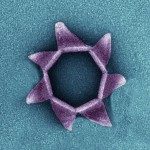Lien vers Pubmed [PMID] – 17605801
BMC Evol. Biol. 2007;7:106
BACKGROUND: As bacteria, motile archaeal species swim by means of rotating flagellum structures driven by a proton gradient force. Interestingly, experimental data have shown that the archaeal flagellum is non-homologous to the bacterial flagellum either in terms of overall structure, components and assembly. The growing number of complete archaeal genomes now permits to investigate the evolution of this unique motility system.
RESULTS: We report here an exhaustive phylogenomic analysis of the components of the archaeal flagellum. In all complete archaeal genomes, the genes coding for flagellum components are co-localized in one or two well-conserved genomic clusters showing two different types of organizations. Despite their small size, these genes harbor a good phylogenetic signal that allows reconstruction of their evolutionary histories. These support a history of mainly vertical inheritance for the components of this unique motility system, and an interesting possible ancient horizontal gene transfer event (HGT) of a whole flagellum-coding gene cluster between Euryarchaeota and Crenarchaeota.
CONCLUSION: Our study is one of the few exhaustive phylogenomics analyses of a non-informational cell machinery from the third domain of life. We propose an evolutionary scenario for the evolution of the components of the archaeal flagellum. Moreover, we show that the components of the archaeal flagellar system have not been frequently transferred among archaeal species, indicating that gene fixation following HGT can also be rare for genes encoding components of large macromolecular complexes with a structural role.

